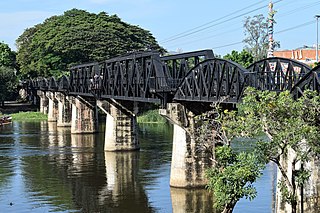
The Burma Railway, also known as the Death Railway, the Siam–Burma Railway, the Thai–Burma Railway and similar names, is a 415 km (258 mi) railway between Ban Pong, Thailand and Thanbyuzayat, Burma. It was built from 1940 to 1943 by civilian labourers impressed or recruited by the Japanese and prisoners of war taken by the Japanese, to supply troops and weapons in the Burma campaign of World War II. It completed the rail link between Bangkok, Thailand, and Rangoon, Burma. The name used by the Japanese Government is Tai–Men Rensetsu Tetsudō (泰緬連接鉄道), which means Thailand-Burma-Link-Railway.

Changi Prison Complex, often known simply as Changi Prison, is a prison in Changi in the eastern part of Singapore.

The Cowra breakout occurred on 5 August 1944, when 1,104 Japanese prisoners of war attempted to escape from a prisoner of war camp near Cowra, in New South Wales, Australia. It was the largest prison escape of World War II, as well as one of the bloodiest. During the escape and ensuing manhunt, four Australian soldiers and 231 Japanese soldiers were killed. The remaining escapees were re-captured and imprisoned.
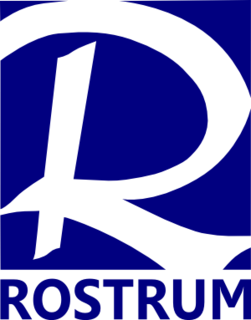
Rostrum Australia is an association of Australian public speaking clubs, founded on 21 July 1930. It is the main continuation of the original Rostrum club founded in Manchester, United Kingdom on 21 July 1923. This club's other surviving descendants are "Rochdale Rostrum", a Rostrum club in the Greater Manchester area founded in 1978; and the presently dormant "Wellington Rostrum Club" in New Zealand.

The Selarang Barracks incident, also known as the Barrack Square incident or the Selarang Square Squeeze, was a revolt of British and Australian prisoners-of-war (POWs) interned in a Japanese camp in Changi, Singapore.
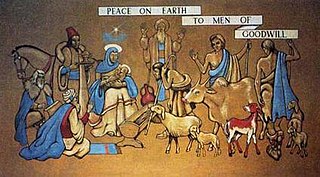
The Changi Murals are a set of five paintings of biblical theme painted by Stanley Warren, a British bombardier and prisoner-of-war (POW) interned at the Changi Prison, during the Japanese occupation of Singapore in World War II (WWII). His murals were completed under difficult conditions of sickness, limited materials and hardships. With a message of universal love and forgiveness, they helped to uplift the spirits of the POWs and sick when they sought refuge in the prison chapel.
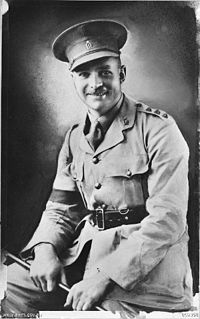
Lionel Colin Matthews, was an Australian Army officer in World War II. He was posthumously awarded the George Cross, the highest award for heroism or courage not in the face of the enemy, that could be awarded to a member of the Australian armed forces at the time. Matthews was born in Adelaide, South Australia, and was schooled there before moving to Victoria. He trained as a signalman in the Royal Australian Naval Reserve before joining the Militia in April 1939. Commissioned as an officer in the Australian Corps of Signals, Matthews transferred to the 8th Division of the Second Australian Imperial Force after the outbreak of World War II.
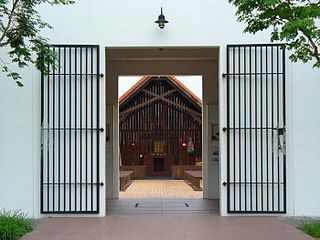
The Changi Chapel and Museum is a war museum dedicated to Singapore's history during the Second World War and the Japanese occupation of Singapore. After the British army was defeated by the Imperial Japanese Army in the Battle of Singapore, thousands of prisoners-of-war (POWs) were imprisoned in Changi prison camp for three and a half years. While interned there, the POWs built numerous chapels, one of which was named St George's Church.

The Changi Air Base is an airfield military airbase of the Republic of Singapore Air Force (RSAF) located at Changi, in the eastern tip of Singapore. Sited at two locations to the east and west of Singapore Changi Airport, it co-shares runway facilities with the civilian airport and currently occupies a third runway slated for future expansion for civilian use by Singapore Changi Airport. Together, the two airfields house 121 Squadron, 112 Squadron, 145 Squadron, the Field Defence Squadron, the Air Logistics Squadron and the Airfield Maintenance Squadron. The air base badge carries the motto Together in Excellence.

Leslie Allan "Peter" Chitty BEM was an Australian rules footballer who played for St Kilda in the Victorian Football League (VFL) and who won the only "Changi Brownlow" awarded in the Prisoner of War Changi Football League.

Major General Sir Frederick Gallagher Galleghan, was a senior officer in the Australian Army who served in the First and Second World Wars.
Operation Whiting was a military operation by Dutch and Australian forces during World War II in New Guinea by M Special Unit. It ran in conjunction with Operation Locust, and resulted in the capture and execution of Leonard Siffleet in October 1943, producing one of the most famous photographs of the war.
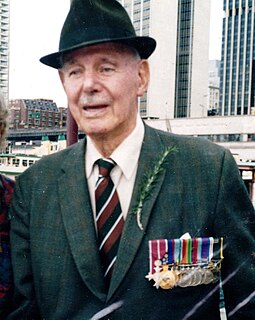
Lieutenant Colonel Reginald William James Newton, was an Australian Army officer noted for his leadership while in Japanese prisoner of war camps during the Second World War. He became well known among Australian military circles, where he was affectionately known as "Roaring Reggie."

Sidney Frederick Wicks was a Congregational minister, public speaking trainer, advertising and business manager, and newspaper executive. He conducted public speaking courses and formed what is now the oldest public speaking club in the world initially called The Rostrum but now simply Rostrum.
Changi University is the nickname given to a program of education for prisoners of war in the Changi Prisoner of War camp in Singapore during World War II. The program's aims were to raise the morale of the prisoners of war and mitigate boredom.
Sir Adrian Herbert Curlewis, was an Australian barrister, captain in WW2, a Changi and Thai-Burma Railway POW and later District Court judge. He was also a sportsman, one of the early surfers in Sydney and later a sports administrator.
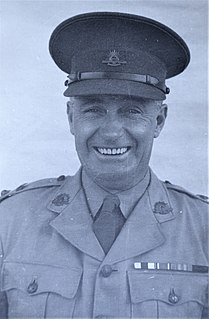
Lieutenant Colonel John Charles Robertson was a senior officer in the Australian Army who served in both the First and Second World Wars.
The three branches of the Australian Defence Force are each represented by flags, among other emblems and insignia. Within each service various symbols fly on individual ships, at bases, camps, the Australian Defence Force Academy and colleges. These include flags, standards, guidons and banners and that denote rank, appointment, corps, formations, regiments, training units and sub units.
Russell Francis Wright, MBE, Service number VX70200, was an Australian radio engineer and soldier.



















